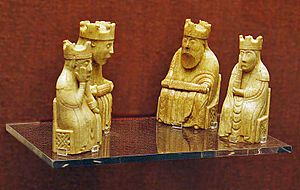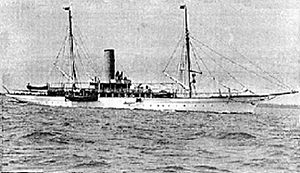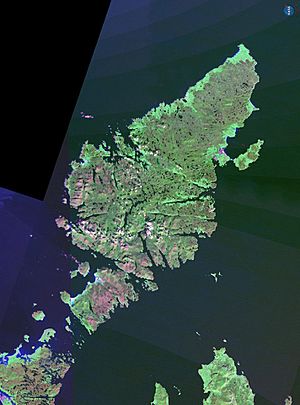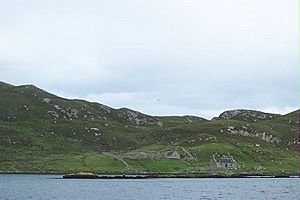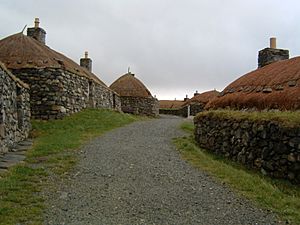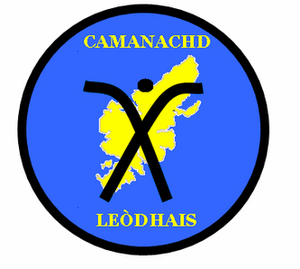Lewis facts for kids
Quick facts for kids Lewis |
|
|---|---|
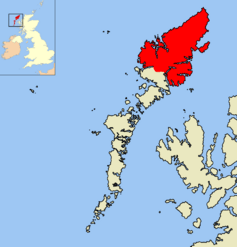 |
|
| Area | 683 sq mi (1,770 km2) |
| Population | 18,500 |
| • Density | 27/sq mi (10/km2) |
| Language | Scottish Gaelic English |
| OS grid reference | NB426340 |
| • Edinburgh | 276 miles (444 km) |
| Council area | |
| Lieutenancy area | |
| Country | Scotland |
| Sovereign state | United Kingdom |
| Post town | STORNOWAY ISLE OF LEWIS |
| Postcode district | HS1, HS2 |
| Dialling code | 01851 |
| Police | Northern |
| Fire | Highlands and Islands |
| Ambulance | Scottish |
| EU Parliament | Scotland |
| UK Parliament |
|
| Scottish Parliament |
|
Lewis (Scottish Gaelic: Leòdhas also Isle of Lewis) is the northern part of Lewis and Harris, the largest island of the Western Isles or Outer Hebrides (an archipelago in Scotland). The total area of Lewis is 683 square miles (1,770 km2).
Lewis is, in general, the lower-lying part of the island: the other part, Harris, is more mountainous. Due to its flatter, more fertile land, Lewis contains three-quarters of the population of the Western Isles, and the largest settlement, Stornoway. The island's diverse habitats are home to an assortment of flora and fauna, such as the golden eagle, red deer and seal, and are recognised in a number of conservation areas.
Lewis has a Presbyterian tradition and a rich history. It was once part of the Norse Kingdom of Mann and the Isles. Today, life is very different from elsewhere in Scotland, with Sabbath observance, the Gaelic language and peat cutting retaining more importance than elsewhere. Lewis has a rich cultural heritage as can be seen from its myths and legends as well as the local literary and musical traditions.
Contents
Name
| Pronunciation | ||
|---|---|---|
| Scots Gaelic: | Eilean Leòdhais | |
| Pronunciation: | ||
| Scots Gaelic: | Eilean an Fhraoich | |
| Pronunciation: | ||
The Gaelic name Leòdhas may be derived from Norse Ljoðahús ("song house"), although other origins have been suggested – most notably the Gaelic leogach ("marshy"). It is probably the place referred to as Limnu by Ptolemy, which also means "marshy". It is also known as the "Isle of Lewis" (Gaelic: Eilean Leòdhais). Another name usually used in a cultural or poetic context is Eilean an Fhraoich, ("Heather Isle"). although this refers to the whole of the island of Lewis and Harris.
History
The earliest evidence of human habitation on Lewis is found in peat samples which indicate that about 8,000 years ago much of the native woodland was torched to make way for grassland to allow deer to graze. The earliest archaeological remains date from about 5,000 years ago. At that time, people began to settle in permanent farms rather than following their herds. The small houses of these people have been found throughout the Western Isles; in particular, at Dail Mhor, Carloway. The more striking great monuments of this period are the temples and communal burial cairns at places like Calanais.
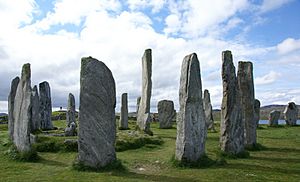
About 500 BC, island society moved into the Iron Age. The buildings became larger and more prominent, culminating in the brochs – circular, dry-stone towers belonging to the local chieftains – testifying to the uncertain nature of life then. The best remaining example of a broch in Lewis is at Dùn Chàrlabhaigh. The Scots arrived during the first centuries AD, bringing the Gaelic language with them. As Christianity began to spread through the islands in the 6th and later centuries, following Columban missionaries, Lewis was inhabited by the Picts.
In the 9th century AD, the Vikings began to settle on Lewis, after years of raiding from the sea. The Norse invaders intermarried with local people and abandoned their pagan beliefs. At that time, rectangular buildings began to supersede round ones, following the Scandinavian style. Lewis became part of the Kingdom of Mann and the Isles, an offshoot of Norway. The Lewis chessmen, found on the island in 1831, date from the time of Viking rule. The people were called the Norse Gaels or Gall-Ghàidheil (lit. "Foreigner Gaels"), reflecting their mixed Scandinavian/Gaelic background, and probably their bilingual speech. The Norse language persists in many island placenames and some personal names to this day, although the latter are fairly evenly spread across the Gàidhealtachd.
Lewis (and the rest of the Western Isles) became part of Scotland once more in 1266: under the Treaty of Perth it was ceded by the Kingdom of Norway. Under Scottish rule, the Lordship of the Isles emerged as the most important power in north-western Scotland by the 14th century. The Lords of the Isles were based on Islay, but controlled all of the Hebrides. They were descended from Somerled (Somhairle) Mac Gillibride, a Gall-Ghàidheil lord who had held the Hebrides and West Coast two hundred years earlier. Control of Lewis itself was initially exercised by the Macleod clan, but after years of feuding and open warfare between and even within local clans, the lands of Clan MacLeod were forfeited to the Scottish Crown in 1597 and were awarded by King James VI to a group of Lowland colonists known as the Fife adventurers in an attempt to anglicise the islands. However the adventurers were unsuccessful, and possession eventually passed to the Mackenzies of Kintail in 1609, when Coinneach, Lord MacKenzie, bought out the lowlanders.
Following the 1745 rebellion, and Prince Charles Edward Stewart's flight to France, the use of Gaelic was discouraged, rents were demanded in cash rather than kind, and the wearing of folk dress was made illegal. Emigration to the New World increasingly became an escape for those who could afford it during the latter half of the century. In 1844 Lewis was bought by Sir James Matheson, co-founder of Jardine Matheson, but subsequent famine and changing land use forced vast numbers off their lands, and increased again the flood of emigrants. Paradoxically, those who remained became ever more congested and impoverished, as large tracts of arable land were set aside for sheep, deer-stalking or grouse shooting. Agitation for land resettlement became acute on Lewis during the economic slump of the 1880s, with several land raids (in common with Skye, Uist and Tiree); this quietened down as the island economy recovered.
During the First World War, thousands of islanders served in the forces, many losing their lives, including 208 naval reservists from the island who were returning home after the war when the Admiralty yacht HMY Iolaire sank within sight of Stornoway harbour. Many servicemen from Lewis served in the Royal Navy and the Merchant Navy during the Second World War, and again many lives were lost. Afterwards, many more inhabitants emigrated to the Americas and mainland Scotland.
In May 1918 the Isle of Lewis was bought by the soap magnate Lord Leverhulme, who intended to make Stornoway an industrial town and build a fish cannery. His plans were initially popular, but his opposition to land resettlement led to further land raids,especially around the farms of Coll, Gress and Tong. These raids, commemorated in monuments in several villages, were ultimately successful, as the government was prepared to take legal action in support of land resettlement. Faced with this, Leverhulme gave up on his plans for Lewis and concentrated his efforts on Harris, where the town of Leverburgh takes his name.
Historical sites
The Isle of Lewis has a variety of locations of historical and archaeological interest, including:
- Callanish Stones
- Dun Carloway Broch
- Iron Age houses near Bostadh (Great Bernera)
- The Garenin blackhouse village in Carloway and the Black House at Arnol
- Bragar whale bone arch
- St Columba's church in Aignish
- Teampull Mholuaidh in Ness
- Clach an Truiseil monolith
- Clach Na Thursa, Carloway
- Bonnie Prince Charlie's Monument, Arnish
- Lews Castle
- Butt of Lewis cliffs and Butt of Lewis Lighthouse
- Dùn Èistean, a small island which is the ancestral home of the Lewis Morrisons
- Ui Church, burial place of the Clan Chiefs MacLeod of Lewis and MacKenzie
There are also numerous lesser stone circles and the remains of five further brochs.
Geography and geology
A cross-section of Lewis would see mostly sandy beaches backed by dunes and machair on the Atlantic west coast, giving way to an expansive peat covered plateau in the centre of the island. The eastern coastline is markedly more rugged and is mostly rocky cliffs broken by small coves and beaches. The more fertile nature of the eastern side led to the majority of the population settling there, including the largest (and only) town, Stornoway. Aside from the village of Achmore in the centre of the island, all settlements are on the coast.
Compared with Harris, Lewis is relatively flat, except in the south-west, where Mealisval, 574 m (1,883 ft), is the highest point, and in the south-east, where Beinn Mhor reaches 572 m (1,877 ft); but there are 16 high points exceeding 300 m (980 ft) in height. Southern Lewis also has a large number of freshwater lochs compared to the north of the island.
South Lewis, Harris and North Uist together comprise a National Scenic Area. There are four geographical Sites of Special Scientific Interest (SSSI) on Lewis – Glen Valtos, Cnoc a' Chapuill, Port of Ness and Tolsta Head.
The coastline is severely indented, creating a number of large sea lochs, such as Lochs Resort and Seaforth, which form part of the border with Harris, Loch Roag, which surrounds the island of Great Bernera, and Loch Erisort. The principal capes are the Butt of Lewis, in the extreme north, with hundred foot (30 m) cliffs (the high point is 142 ft (43 m) high) and crowned with a lighthouse, the light of which is visible for 19 miles (31 km); Tolsta Head, Tiumpan Head and Cabag Head, on the east; Renish Point, in the extreme south; and, on the west, Toe Head and Gallon Head. The largest island associated with Lewis is Bernera or Great Bernera in the district of Uig and is linked to the mainland of Lewis by a bridge opened in 1953.
Geology
The geology of Lewis is dominated by the metamorphic gneisses of the eponymous Lewisian complex. Exceptions are a patch of granite near Carloway, small bands of intrusive basalt at Gress and in Eye Peninsula and some sandstone at Stornoway, Tong, Vatisker and Carloway, which was originally thought to be Torridonian, but is now considered more likely to be Permo-Triassic in age.
Climate
Exposure to the Atlantic Ocean and the Gulf Stream lead to a cool, moist climate on Lewis. There is little temperature difference between summer and winter, both of which are very cloudy, with significant rainfall and frequent high winds, particularly during the autumn equinox. These winds have led to Lewis being designated a potential site for a significant wind-farm which has caused much controversy amongst the population.
| Climate data for Lewis | |||||||||||||
|---|---|---|---|---|---|---|---|---|---|---|---|---|---|
| Month | Jan | Feb | Mar | Apr | May | Jun | Jul | Aug | Sep | Oct | Nov | Dec | Year |
| Average high °C (°F) | 7 (45) |
7 (45) |
8 (46) |
10 (50) |
12 (54) |
14 (57) |
16 (61) |
16 (61) |
14 (57) |
12 (54) |
9 (48) |
7 (45) |
11 (52) |
| Average low °C (°F) | 2 (36) |
2 (36) |
2 (36) |
3 (37) |
6 (43) |
8 (46) |
10 (50) |
10 (50) |
8 (46) |
6 (43) |
4 (39) |
2 (36) |
5 (41) |
| Average rainfall mm (inches) | 134.41 (5.29) |
98.48 (3.88) |
93.86 (3.70) |
72.70 (2.86) |
61.86 (2.44) |
64.89 (2.55) |
74.21 (2.92) |
89.63 (3.53) |
106.44 (4.19) |
132.21 (5.21) |
132.37 (5.21) |
135.78 (5.35) |
1,197 (47.1) |
| Mean monthly sunshine hours | 34.46 | 63.43 | 104.85 | 147.07 | 192.18 | 166.44 | 127.94 | 132.57 | 106.63 | 77.19 | 44.26 | 26.21 | 1,223 |
| Source: Met Office (Data January 1874 – November 2006)
Temperature figures are average figures for that month; other figures are averages of monthly totals. |
|||||||||||||
Nature
There are 15 Sites of Special Scientific Interest on Lewis in the biology category, spread across the island. Additionally, the Lewis Peatlands are recognised by Scottish Natural Heritage as a Special Protection Area, Special Area of Conservation and a Ramsar site, showing their importance as a wetland habitat for migratory and resident bird life.
Birds
Many species of seabirds inhabit the coastal areas of Lewis, including shag, gannets, fulmars, kittiwakes, guillemots, and the ubiquitous gulls. Red grouse and woodcock are found in the interior.
In the Uig hills, it is possible to spot golden eagles; it has also been claimed that white-tailed eagles have been seen in the area. In the Pairc area, one can see feeding oyster catchers and curlews. A few pairs of peregrine falcons inhabit the coastal cliffs and merlin and buzzard are common everywhere on hill and moor. An important feature of the winter bird life is the great diversity of wildfowl. Several varieties of duck, including eider and long-tailed, are found in the shallow water around Lewis.
Marine life
Salmon frequent several Lewis rivers after crossing the Atlantic. Many of the fresh-water lochs are home to fish such as trout. Other freshwater fish present include Arctic char, European eel, 3 and 9 spined sticklebacks, thick-lipped mullet and flounder.
Offshore, it is common to see seals, particularly in Stornoway harbour, and with luck, dolphins, porpoises, sharks and even the occasional whale can be encountered.
Land mammals
There are only two native land mammals in the Western Isles: red deer and otter. The rabbit, blue hare, hedgehog, brown and black rat, feral cat, mink and polecat were introduced. The origin of mice and voles is uncertain.
American mink, another introduced species (escapees from fur farms), cause problems for native ground-nesting birds, the local fishing industry and poultry farmers. Mink have been successfully eradicated from the Uists and Barra. The second and ongoing phase of the Hebridean Mink Project aims to rid Lewis and Harris of mink in similar fashion.
There are claims that the Stornoway castle grounds are home to bats. In addition, some residents keep farm animals such as Hebridean sheep, Highland cattle or kyloe and a few pigs.
Reptiles and amphibians
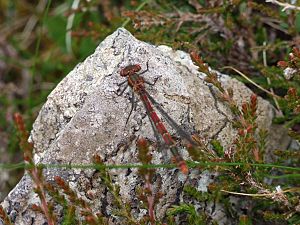
In common with Ireland, no snakes inhabit Lewis, only the slow-worm which is merely mistaken for a snake. Actually a legless lizard, it is the sole member of its order present. The common frog may be found in the centre of the island though it, along with any newts or toads present are introduced species.
Insects
The island's most famous insect resident is the Scottish midge which is ever-present near water at certain times of the year.
During the summer months, several species of butterflies and dragonflies can be found, especially around Stornoway.
The richness of insect life in Lewis is evident from the abundance of carnivorous plants that thrive in parts of the island.
Plant life
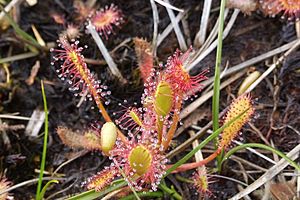
The machair is noted for different species of orchid and associated vegetation such as various grasses. Three heathers; ling, bell heather and cross-leaved heather are predominant in the large areas of moorland vegetation which also holds large numbers of insectivorous plants such as sundews. The expanse of heather-covered moorland explains the name Eilean an Fhraoich, Gaelic for "The Heather Isle".
Lewis was once covered by woodland, but the only natural woods remaining are in small pockets on inland cliffs and on islands within lochs, away from fire and sheep. In recent years, Forestry Commission plantations of spruce and pine were planted, although most of the pines were destroyed by moth infestation. The most important mixed woods are those planted around Lews Castle in Stornoway, dating from the mid-19th century.
Demographics
Lewis' main settlement, the only burgh on the Outer Hebrides, is Stornoway (Steòrnabhagh), from which ferries sail to Ullapool on the Scottish mainland. In the 2001 census Lewis had a usually resident population of 18,489.
The island's settlements are on or near the coasts or sea lochs, being particularly concentrated on the north east coast. The interior of the island is a large area of moorland from which peat was traditionally cut as fuel, although this practice has become less common. The southern part of the island, adjoining Harris, is more mountainous with inland lochs.
Parishes and districts of Lewis
- There are four parishes: Barvas (Barabhas), Lochs (Na Lochan), Stornoway (Steòrnabhagh), and Uig on which the original civil registration districts were based. The district of Carloway (after the village of that name) which hitherto had fallen partly within the parishes of Lochs and Uig, became a separate civil registration district in 1859.
- The districts of Lewis are Ness (Nis), Carloway (Càrlabhagh), Back, Lochs (Na Lochan), Park (A' Phàirc), Point (An Rubha), Stornoway, and Uig. These designations are traditional and in use by the entire population.
- For civil registration purposes Lochs (Na Lochan) is nowadays split into North Lochs (Na Lochan a Tuath) and South Lochs (Na Lochan a Deas).
- The West Side is a generic designation for the area covering the villages from Borve to Dalbeg (Siabost).
It is claimed that the site of the Stornoway War Memorial was chosen as it would be visible from at least one location in each of the four parishes; therefore, it may be possible to see all four parishes of Lewis from the top of the monument.
Settlements
While Lewis has only one town, Stornoway, with a population of approx 8,000, there are also several large villages and groupings of villages on Lewis, such as North Tolsta, Carloway and Leurbost with significant populations. Near Stornoway, Laxdale, Sandwick and Holm, although still de facto villages, have now become quasi-suburbs of Stornoway. The population of the greater-Stornoway area including these (and other) villages would be nearer 12,000. The island of Great Bernera contains the first planned crofting township created in the Outer Hebrides, Kirkibost created in 1805. This village was subsequently 'cleared' in 1823 and re-settled in 1878 using the exact land lotting divisions from 1805.
The following is a non-exhaustive list of villages in Lewis according to their location:
- Back
- Back, Coll, Gress, North Tolsta, Tong
- Ness
- Melbost, South Galson, North Galson, South Dell, North Dell, Cross, Swainbost, Habost, Lionel, Port of Ness, Eoropie, Fivepenny, Knockaird, Adabrock, Eorodale, Skigersta, Cross-Skigersta Road
- North Lochs
- Achmore, Grimshader, Leurbost, Ranish, Crossbost, Keose, Keose Glebe, Laxay, Balallan, Airidhbhruaich
- Park (South Lochs)
- Shieldenish, Habost, Kershader, Garyvard, Caverstay, Cromore, Marvig, Calbost, Gravir, Lemreway, Orinsay
- Point
- Aird, Aignish, Flesherin, Lower Bayble, Portnaguran, Portvoller, Sheshader, Shulishader, Upper Bayble, Eagleton
- Uig
- Aird Uig, Cliff, Kneep, Timsgarry, Valtos, Breanish, Islivik, Meavik, Mangursta, Crowlista, Geishader, Carishader, Gisla, Carloway, Garynahine, Callanish, Breasclete, Breaclete, Kirkibost, Tobson, Hacklete
- West Side
- Arnol, Ballantrushal, Barvas, Borve, Bragar, Brue, Shader, Shawbost, Dalbeg
- Stornoway area
- Branahuie, Holm, Laxdale, Marybank, Melbost, Newmarket, Newvalley, Parkend, Plasterfield, Sandwick, Steinish
Religion
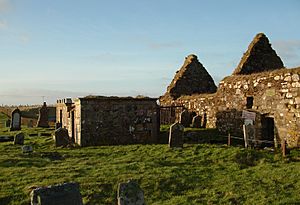
Religion is important in Lewis, with much of the population belonging to the Free Church and Church of Scotland (both Presbyterian in tradition). The Sabbath is generally observed with most shops and licensed premises closed on that day, although there is a scheduled air service to mainland Scotland as well as a scheduled ferry service from 19 July 2009. While Presbyterianism dominates Lewis, other denominations and other religions have a presence with a Catholic church, a Salvation Army corps, a Pentecostal church (New Wine Church), a Brethren church, a Baptist church, a meetinghouse of the LDS Church and a Jehovah's Witness Kingdom Hall all present in Stornoway.
Culture and sport
Language
Lewis has a linguistic heritage rooted in Scottish Gaelic and Old Norse, which both continue to influence life in Lewis. Today, both Gaelic and English are spoken in Lewis, but in day-to-day life, a hybrid of English and Gaelic is very common. As a result of the Gaelic influence, the Lewis accent of Highland English is frequently considered to sound more Irish or Welsh than stereotypically Scottish in some quarters. The Gaelic culture in the Western Isles is more prominent than in any other part of Scotland. Gaelic is the language of choice amongst many islanders and around 60% of islanders speak Gaelic as a daily language, whilst 70% of the resident population have some knowledge of Gaelic (including reading, writing, speaking or a combination of the three). Most signposts on the islands are written in both English and Gaelic and much day-to-day business is carried out in the Gaelic language. Almost all of the Gaelic speakers are bilingual.
Most of the place names in Lewis and Harris come from Old Norse. The name "Lewis" is the English spelling of the Gaelic Leòdhas which comes from the Old Norse Ljóðhús, as Lewis is named in medieval Norwegian maps of the island. Various suggestions have been made as to a Norse meaning such as "song house". The name is not of Gaelic origin, the Norse credentials are questionable and it may have a pre-Celtic root.
Media and the arts
As well as regularly playing host to the Royal National Mòd, there are annual local mods. Stornoway Castle Green hosts the annual 3 day Hebridean Celtic Festival in July, attracting over 10,000 visitors. The festival includes events such as ceilidhs, dances and special concerts featuring storytelling, song and music with performers from all round the Isles and beyond.
The radio station Isles FM is based in Stornoway and broadcasts on 103FM, featuring a mixture of Gaelic and English programming. The town is also home to a studio operated by BBC Radio nan Gàidheal, and Studio Alba, an independent television studio from where the Gaelic TV channel TeleG was broadcast.
The Stornoway Gazette is the main local paper, covering Lewis and beyond and is published weekly. The Hebridean is a sister paper of the Gazette and also provides local coverage. Some community organisations in the rural districts have their own publications with news and features for these particular areas, such as the Rudhach for the Point district.
Lewis has been home to, or inspired, many writers, including bestselling contemporary author Kevin MacNeil, whose cult novel The Stornoway Way was set in the island's capital.
Sport
There is a good provision of sporting grounds and sports centres in Lewis. Sports such as Football, Rugby union and Golf are popular.
- Football, which grew in popularity after the first World War, is the most popular amateur sport in Lewis with Goathill Park in Stornoway hosting special matches involving select teams and visiting clubs and other organisations. Local teams currently participate in the Lewis and Harris Football League.
- Shinty which was traditionally played in the island as in the rest of the Gaelic-speaking areas of Scotland, died out by the mid-20th century at the latest. However, it was revived in the 1990s and there is now a strong local club known as Lewis Camanachd which competes in national competition.
- The village of Tong about 2 miles (3 km) from Stornoway plays host to the Highland Games and the Western Isles Strongest man competition each summer.
- Attached to the Nicolson Institute School is the Ionad Spors Leòdhais (Lewis Sports Centre), an all-weather pitch and running track.
- The Lews Castle Grounds is the home of Stornoway Golf Club (the only 18-hole golf course in the Outer Hebrides).
- Angling is a very popular pastime in Lewis as there are several good lochs and rivers for fishing.
- As Lewis is an island, various water sports, such as surfing are popular activities.
- Lewis has a terrain very suited to hillwalking, particularly in Uig and near the border with Harris.
Myths and legends
The Isle of Lewis has a rich folklore, including Seonaidh – a water-spirit who had to be offered ale in the area of Teampull Mholuaidh in Ness – and The Blue Men who inhabited the Minch, between Lewis and the Shiants.
Gastronomy
- Each year, men from Ness go out to the island of Sula Sgeir in late August for two weeks to harvest young gannets known locally as Guga, which are a local delicacy.
People with Lewis connections
- Alistair Darling, former Chancellor of the Exchequer and MP for Edinburgh Central has a house in the village of Breacleit, Bernera and is of Bernera parentage.
- Andy Gray, former footballer and Sky Sports pundit, his Grandmother hails from the village of Back
- Sheilagh M. Kesting, first woman minister to be nominated to be Moderator of the General Assembly of the Church of Scotland
- Angus MacAskill, the strongest man to have ever lived – born in Berneray and briefly lived in Stornoway before emigrating to Canada
- Murdo Stewart MacDonald from Great Bernera – Clipper Captain and Lloyds Surveyor of Shipping
- Callum Macdonald from Great Bernera – Foremost publisher of Scottish poetry in the 20th century
- Cathy MacDonald, foremost presenter on BBC Alba television channel comes from Iarsiadar, Uig
- John MacKay, anchorman of STV News at 6 Central
- Alexander MacKenzie, explorer, after whom the Mackenzie River in Canada is named
- Colin Mackenzie, 1st Surveyor-General of India
- Anne MacKenzie, BBC current affairs presenter and radio presenter
- Ken MacLeod, science fiction writer
- Kevin MacNeil, novelist, poet and playwright
- Hans Matheson, plays the title role in Granada's £8.5m serialisation of Boris Pasternak's novel, Doctor Zhivago
- Linda Norgrove, kidnapped by the Taliban in Afghanistan, and killed in rescue effort
- Alyth McCormack, singer
- Iain Morrison, musician
- Jim Morrison, Morrison family originally from Isle of Lewis
- Arthur Pink, Christian evangelist and Biblical scholar
- Donald Stewart, politician and former leader of the Scottish National Party
- Derick Thomson, Scottish Gaelic poet, from Point, and educated in Stornoway
- Donald Trump, president of the United States, whose mother Mary Anne MacLeod Trump came from Tong
- Alasdair White, musician (Fiddle, Whistle, Pipes, Bouzouki) plays with Battlefield Band
See also
 In Spanish: Lewis para niños
In Spanish: Lewis para niños


